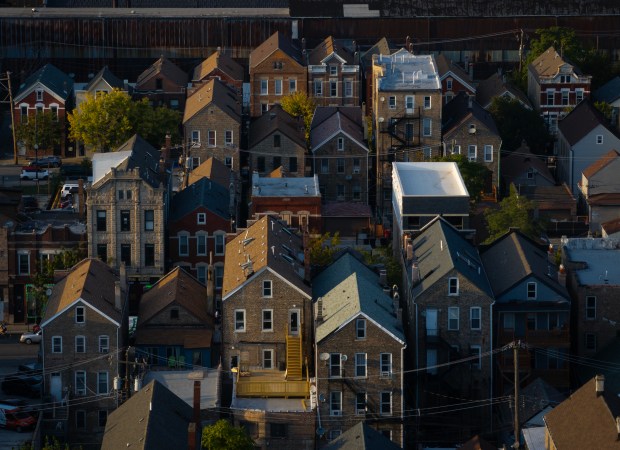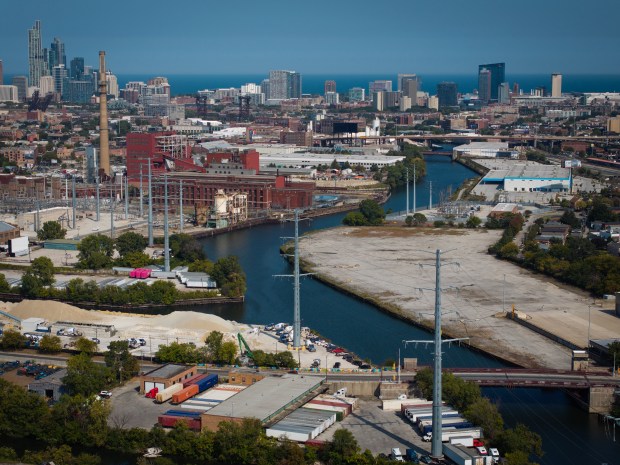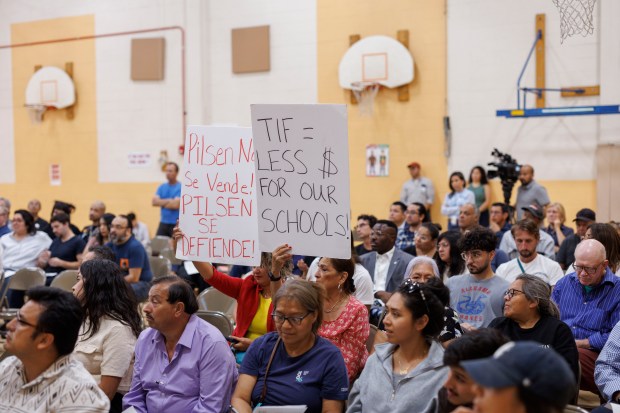Signs of local pushback against the property tax zone expansion progressive Ald. Byron Sigcho-Lopez favors are readily apparent in Pilsen in his Southwest Side ward.
There are the purple signs posted along Ashland Avenue that read: “Pilsen no se vende se defiende | No TIF expansion | Pilsen is not for sale.” Plastered on the windows of the office of Pilsen Alliance, a grassroots organization Sigcho-Lopez led roughly six years ago, are flyers encouraging passersby to write to their alderman against it.
The sentiment bubbling through the neighborhood puts Sigcho-Lopez, a firebrand City Council ally of Mayor Brandon Johnson, in an uncomfortable spot.
Progressives such as Johnson and Sigcho-Lopez have traditionally railed against tax increment financing districts, which freeze for decades the property tax revenues distributed to schools, parks and other government bodies and instead earmark those funds for projects within the boundaries.
While TIF proponents say those projects spur economic development, opponents often decry the spending as a handout for private developers, or unnecessary in areas that are already thriving.
Earlier this year, Johnson moved to shift the city away from a reliance on the controversial economic development tool, arguing the revenues trapped in certain neighborhood TIFs should be free to use citywide, especially in historically disinvested areas, or opened back up to other government bodies such as Chicago Public Schools.
Pilsen, the mayor and Sigcho-Lopez now contend, is an exception.
The TIF should grow by more than 685 acres and 6,000 parcels to help meet “critical goals of the community,” according to the city’s planning department. The gentrifying neighborhood’s current TIF would expand north to cover more homes and businesses — including the iconic stretch of shops and restaurants along 18th Street — capturing nearly $1 billion in property tax revenues over the next decade, according to city estimates. That’s exponentially more than the roughly $115 million the current TIF district was slated to raise in that time.
Those dollars would jump-start public projects and provide relief to Pilsen residents drowning in rising property tax bills and expensive repairs to their homes and businesses, Sigcho-Lopez told the Tribune.
But in addition to the people who live there who are passionately opposed to the idea, several of Sigcho-Lopez’s City Council colleagues are reluctant.
They worry about the impact an expanded Pilsen TIF would have on the rest of the city’s property tax burden in a grueling budget year, since any growth in tax revenue would be trapped in the boundaries rather than available to help deal with the budget gap.
Critics wonder, too, whether it’s fair to offer tax relief or home repair help to residents in one neighborhood while leaving others out.
Neighboring Ald. Nicole Lee’s 11th Ward includes a slice of the current TIF. Her immediate reaction to the proposal, she told the Tribune, was “Wow, this is really big, size-wise. … Really, why is this thing so big?”
If passed, the TIF expansion would blanket nearly all of Pilsen, and much of the southwest side between Roosevelt, Western, Archer and the Dan Ryan would be covered in TIF.
Scroll the map below to see the current and proposed Pilsen TIF district boundaries. Use the layer function on the right to toggle district boundaries on or off and get a better look at a specific geometry.
Proponents have sold the expansion as a way to double down on urgently-needed public projects: The bigger TIF would cover several more public schools, parks and the Rudy Lozano Public Library branch. Of the expanded TIF’s $980 million projected budget over the next decade, about $440 million would be spent on public works and improvements like fixing up the library and local schools or replacing the Halsted bridge, according to the city’s Department of Planning and Development.
The TIF has already helped pay for a new library space, science classrooms and a computer room at Whittier Elementary; a new soccer field for Juarez Community Academy; improvements to the roof, windows and masonry at Perez Elementary; and capital improvements to neighborhood parks and the Paseo Trail.
Given its reputation as a booming site of gentrification, does the expanded area qualify as “blighted” under state law? The city’s Department of Planning and Development says yes. More than half of the buildings in the expansion area are at least 35 years old, there are “inadequate utilities,” “deterioration,” the presence of “structures below minimum code standards,” and “excessive vacancies.”
$200 million of the expanded TIF dollars would go toward rehabbing existing buildings or the construction of affordable housing, according to DPD. That includes supercharging two projects already in the TIF’s current boundaries: Casa Yucatan and a two-block development at 18th and Peoria, which would include affordable housing and commercial space.

$200 million would go to property acquisition and site cleanup for other TIF initiatives, according to DPD. Funds could also go directly to home repairs through the TIF-Neighborhood Improvement Program, small business support, and property tax relief, according to a presentation Sigcho-Lopez’s office gave earlier this month.
A committee vote approving the expansion was scheduled to take place Sept. 16. Aldermen on the Finance Committee raised enough questions ahead of the meeting to force a deferral.
For Lee, the scale-up seemed “a total change of course” from Johnson’s TIF stance. The mayor passed his signature bond initiative — funded with property taxes made available after multiple TIFs expire in the coming years — “on the premise that we were going to be moving away from TIFs as a tool and being much more judicious about it,” Lee said.
“I’m not against affordable housing, I’d love for the Rudy Lozano library to get a new library to serve more people in the community,” Lee said.
But she was not the only alderman to express concerns about the precedent the expansion would set. “If we’re going to do this here, why wouldn’t somebody in Bucktown say, ‘Let’s expand our boundaries here so we can do what we want to do?’” Lee asked.
Fellow progressive Julia Ramirez, 12th Ward, told the Tribune she could not “in good conscience” go forward with a vote last week with so many unanswered questions.
“Pick any community, we all have our needs. Pilsen definitely has their plight, considering the amount of tax increase that residents have faced. I’m very sensitive to that, I’m open to have a dialogue,” Ramirez said. “But for me, it’s like, is it responsible?”

Ramirez wondered whether her constituents in McKinley Park and Brighton Park would benefit. “As an alderwoman now of the 12th Ward, sharing the TIFs I have, you always think, ‘What can I take back to my community? What does that access mean for me?’ It seemed like there wasn’t much,” Ramirez said.
Still, Ramirez is torn. “My family came to Pilsen when they moved from Mexico. I love Pilsen. I’d love for them to get support, but here in 12 and any other part of the city is deserving of that too,” she said.
Public comment in that meeting similarly highlighted divisions.
Pilsen resident Steve Vidal urged the expansion. In many ways, he embodied the possibilities of what a larger TIF could pay for under Sigcho-Lopez’s vision.
Vidal teaches at Juarez Community Academy, and his family owns a 130-year-old building in the neighborhood where property taxes have tripled over the last five years, he said, forcing him to put off repairs and raise rents on tenants. The sidewalks nearby are so damaged that his neighbor who uses a wheelchair has to navigate in the street, Vidal said.
The nonprofit Resurrection Project, where Vidal is a leader of the Pilsen Mi Hogar Collective, is also benefiting from TIF funding to build the 98-unit affordable development at Casa Yucatan.
Julie Sawicki, president of the Society of St. Adalbert, followed with some of the day’s sharpest opposition. She suggested Sigcho-Lopez was misleading members of the public about what the TIF could accomplish. In public presentations, the alderman has said Cook County Assessor Fritz Kaegi “is committed to helping Pilsen residents advocate for legislative changes to use TIF funds for property tax relief.”
“That people will be able to pay their property taxes with TIF money” is not a permissible use for TIF dollars under state law, Sawicki noted, a concern several aldermen told the Tribune they shared. “This is pie in the sky, highly unlikely, but our vulnerable community, some of our residents are buying this hook, line and sinker,” she said.
While local officials, including Kaegi, support “circuit breaker” reforms to give property tax relief to low-income individuals, a spokesman said Kaegi is “not, at this time, advocating for the city of Chicago to” push for a state law change to allow TIF to pay for it.
Sigcho-Lopez still expects to take up the issue early next month, and has decried “misinformation” he said is sowing discord in the community.
“We have not done all the work in terms of Pilsen preservation just to allow the displacement of more people,” he told the Tribune. “The Pilsen community had the highest property taxes in the city, in the county, almost, and our communities need help. … We have schools — Cooper doesn’t have a playground, Whittier is having a floor that is caving in. We have major repairs that CPS is not covering. … (Lozano Library doesn’t) have working AC.”
Ald. Lee, he said, “seems to be OK” with spending billions on police misconduct settlements, Sigcho-Lopez said. “She was fine taking TIF money for other infrastructure plans.”
He chalked up the Pilsen Alliance’s opposition to them being “from outside the community, with other agendas.”

One of the alliance’s board members, tenant organizer Javier Ruiz, said he lives two blocks outside the neighborhood, but inside the 25th Ward. And while some opponents who have signed some of the hundreds of petition signatures in opposition do not live in the ward, he told the Tribune TIFs affect the whole city.
“Whether they’re used for a good cause or not, TIFs in general still work by diverting property taxes away from the normal taxing bodies like CPS, Cook County, etc. So you could say ‘We’re going to use the money for a good cause,’ but you’re still diverting the money from other neighborhoods,” Ruiz told the Tribune, adding his organization was also upset Sigcho-Lopez did not engage in more robust community engagement earlier in the process.
Asked Wednesday why he supported this TIF’s expansion but the phaseout of others, the mayor said “That conversation is still going on and the community is very much interested in providing some significant development that could create jobs in the immediate (future).
“The reason why we have changed course as it relates to TIFs is because what this TIF is attempting to do for this library, TIFs were not doing,” Johnson said. “Yes, we were winding down but keep in mind, not all TIFs will be eliminated.”
As for whether he supported a change in state law to allow TIF money to be used for property tax relief, Johnson said “everything is on the table.”
First drawn in 1998, the Pilsen TIF is bounded roughly by Cullerton Street on the north, the expressway on the south, Western on the west and the river on the east. Then, too, it was the subject of protests from some locals concerned about rising property taxes and gentrification ushered in by new commercial interests moving into the area.
During Mayor Richard M. Daley’s TIF blitz, it was set up to maximize the neighborhood’s riverfront industrial corridor. The money raised helped subsidize the relocation of Steiner Linen to Leavitt Street, construction of a more than 400,000-square-foot produce warehouse and distribution center, and construction of a new Target store at 33rd and Damen. The Pilsen TIF ended 2023 with $105 million in the bank.
Rather than providing corporate subsidies, the Rev. Brendan Curran, a Dominican priest who helps manage interfaith partnerships at The Resurrection Project, said the plans for the expanded TIF provide a public, progressive and common good. “That is the design, the approach, and the reason why (former Mayor) Harold Washington launched this. He was not trying to suck money from the general budget.”
Affordable housing, bridge repairs and school improvements won’t just benefit Pilsen residents, but others in Chinatown, Little Village and Brighton Park, he argued. Using TIF for expensive but needed fixes will alleviate a bigger burden on budgets down the line, he said. “Sooner or later, we all have to pay for it.”



